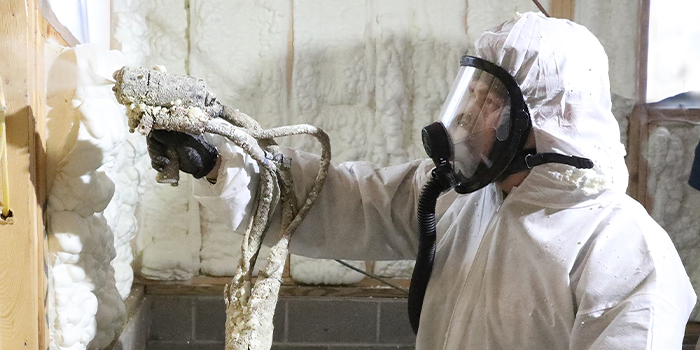Sustainability Of Our Industry And Your Business


HOUSTON, TX – May 3, 2018 – You’ve worked hard to grow your spray foam business and we’ve all enjoyed a steadily expanding SPF market. Life’s been pretty good for spray foam, especially when compared to other industries that were more affected than ours by economic pressures of the past decade. Everyone in the spray foam value chain has enjoyed a growing market, but what would happen to your business if the spray foam industry suddenly shrinks? Thankfully, there’s two industry associations working hard to protect our market, but unless we all work responsibly, nothing is guaranteed.
The two organizations focused exclusively on the betterment of everyone in spray foam are the Spray Polyurethane Foam Alliance (SPFA) and the Spray Foam Coalition (SFC). Both are focused on building and protecting our spray foam market but from different perspectives. The SPFA focuses on contractor needs that include training, as well as OSHA and EPA requirements. The SFC is organized through the American Chemistry Council’s Center for Polyurethanes Industry and is a manufacturer’s organization with a primary emphasis on expanding the marketplace for all SPF. Both organizations do outstanding work. Both are 100 percent voluntary to join and participate in, and have strict anti-trust guidelines. In accordance with federal statutes, neither allows certain activities which restrict market access and neither governs the way any company goes to market, whether they’re members or not.
Over the years, some have asked why we don’t require more from spray foam applicators and contractors like training and certification. Some have asked that manufacturers be held to different standards, but at the end of the day, we appreciate being able to operate free of burdensome regulation, and with that freedom comes with shared responsibility.
Our manufacturers need to produce great products with support to installers so their materials can be used safely and provide a healthy and comfortable indoor environment for homeowners and building occupants. Our installers need to operate in accordance with best industry practices and run their business in an ethical and honorable manner. Collectively, we need to always manufacture, promote, and install our spray foam in compliance with applicable codes and according to universally accepted standards.
Training to those standards is imperative to making sure everyone understands and applies the right knowledge, skills, and abilities. The SPFA Professional Certification Program has been universally accepted by manufacturers, insurance providers, architects, and government agencies – and certified applicators are respected across the industry.
Manufacturers have a different set of requirements and certifications. In order to be sold as insulation, spray foam manufacturers must test and declare R-value in accordance with FTC rules. There are code-mandated standards for air permeance and vapor diffusion, and there are material specs for flame spread, smoke development, heat release, and a myriad of other fire properties. Manufacturers who list their products with organizations like ICC Evaluation Service, Intertek, IAPMO, and ABAA are required to operate under a quality assurance plan, which includes product consistency, sample retention, and warranty reporting, to name a few.
Building officials trust and rely on these organizations to publish evaluation reports so the individual inspector doesn’t have to do extensive research for products not cited prescriptively in the code but claimed to meet the intent or spirit of the code. Our spray foam industry has benefited greatly by evaluation reports (also known as research reports), which means a third-party reads laboratory test results and other documents submitted by the manufacturer and then writes a report based on a written acceptance criterion. We also have guidelines from EPA and CPI for ventilation of the spray zone, re-entry, and re-occupancy after spraying foam, and since we all use the same MDI for our A side, it seems reasonable that all brands of foam would be about the same.

By sustaining the spray foam industry, businesses can profit and prosper
Each of us must be a good steward of our industry. We need to comply with our long-established standards and operate according to best industry practices. When we do, it benefits everyone in the spray foam value chain from basic chemical suppliers to systems houses, distributors, contractors, and applicators. We can’t afford to take shortcuts or forsake well-established standards, processes, and procedures for short-term profit. In this day and age, it’s reasonable to wonder if our industry is durable enough to continue to grow if a major problem related to spray foam arises.
Ask your customers how they learned about spray foam and most will tell you they researched it on the internet. Both SPF industry associations have excellent websites populated with very positive information, as do all of the spray foam manufacturers and many contractors, and —of course—SprayFoam.com. There are also naysayers who latch onto any negative information, true or not, and often blow it way out of proportion. In our internet-driven economy where anything posted on the web seems to remain there forever, can we really afford to have a high-profile fire or death-related incident to this non-standard fire control protocol?
About 10 years ago, there was a class-action lawsuit lodged in a number of states against a number of manufacturers and contractors. According to public record, multi-district status was never allowed, a class was never formed, and it appears the suit was not successful. That didn’t stop the internet trolls from litigating it in forums and websites dedicated to the destruction of our industry. We survived that dark era, but one has to wonder how much more our industry could have grown had we not had those allegations to defend; those distractions from our common goal of growing our market and our company’s market share.
Most of that is finally behind us so we’re again making good progress with SPF’s market share in the insulation industry, and our contractors are busier and more profitable than ever. We must all do our part in protecting and sustaining our SPF market by sticking to the best practices and using only universally accepted health and safety protocols and fire protection standards.
Sustain our spray foam industry and we will all profit and prosper.
Contact SES FOAM
Direct any questions about using the sustainability of the industry to SES Foam:
Phone: 855-335-2440 / 713-239-0252
Website: www.sesfoam.com
*Spray Foam Magazine does not take editorial positions on particular issues; individual contributions to the magazine express the opinions of discrete authors unless explicitly labeled or otherwise stated. The inclusion of a particular piece in the magazine does not mean that individual staff members or editors concur with the editorial positions represented therein.
Disqus website name not provided.










































